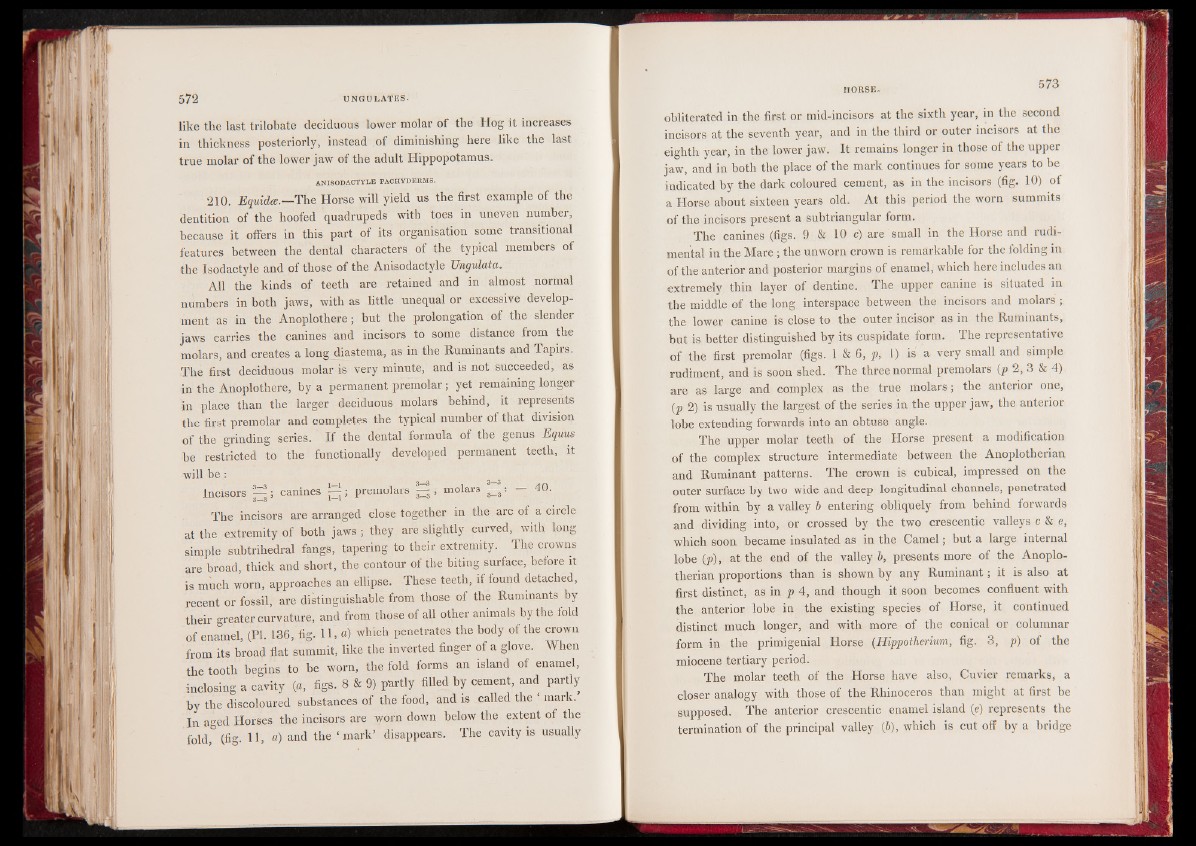
like the last trilobate deciduous lower molar of the Hog it increases
in thickness posteriorly, instead of diminishing here like the last
true molar of the lower jaw of the adult Hippopotamus.
ANISODACTYLE PACHYDERMS.
210. Equidce.—The Horse will yield us the first example of the
dentition of the hoofed quadrupeds with toes in uneven number,
because it offers in this part of its organisation some transitional
features between the dental characters of the typical members of
the Isodactyle and of those of the Anisodactyle Ungulata.
All the kinds of teeth are retained and in almost normal
numbers in both jaws, with as little unequal or excessive development
as in the Anoplothere; but the prolongation of the slender
jaws carries the canines and incisors to some distance from the
molars, and creates a long diastema, as in the Ruminants and Tapirs.
The first deciduous molar is very minute, and is not succeeded, as
in the Anoplothere, by a permanent premolar; yet remaining longer
in place than the larger deciduous molars behind, it represents
the first premolar and completes the typical number of that division
of the grinding series. If the dental formula of the genus Equus
be restricted to the functionally developed permanent teeth, it
will be :
Incisors canines ^ ; premolars — ; molars — : = 4®-
The incisors are arranged close together in the arc of a circle
at the extremity of both jaws ; they are slightly curved, with long
simple subtrihedral fangs, tapering to their extremity. The crowns
are broad, thick and short, the contour of the biting surface, before it
is much worn, approaches an ellipse. These teeth, if found detached,
recent or fossil, a r e distinguishable from those of the Ruminants by
their greater curvature, and from those of all other animals by the fold
of enamel, (PI. 136, fig. 11, a) which penetrates the body of the crown
from its broad flat summit, like the inverted finger of a glove. When
the tooth begins to be worn, the fold forms an island of enamel,
inclosing a cavity (a, figs. 8 & 9) partly filled by cement, and partly
by the discoloured substances of the food, and is called the ‘ mark.
In aged Horses the incisors are worn down below the extent of the
fold, (fig. 11, a) and the ‘mark’ disappears. The cavity is usually
obliterated in the first or mid-incisors at the sixth year, in the second
incisors at the seventh year, and in the third or outer incisors at the
eighth year, in the lower jaw. It remains longer in those of the upper
jaw, and in both the place of the mark continues for some years to be
indicated by the dark coloured cement, as in the incisors (fig. 10) of
a Horse about sixteen years old. At this period the worn summits
of the incisors present a subtriangular form.
The canines (figs. 9 & 10 c) are small in the Horse and rudi-
mental in the Mare ; the unworn crown is remarkable for the folding in
of the anterior and posterior margins of enamel, which here includes an
extremely thin layer of dentine. The upper canine is situated in
the middle of the long interspace between the incisors and molars ;
the lower canine is close to the outer incisor as in the Ruminants,
but is better distinguished by its cuspidate form. The representative
of the first premolar (figs. 1 & 6, p, 1) is a very small and simple
rudiment, and is soon shed. The three normal premolars (p 2, 3 & 4)
are as large and complex as the true molars; the anterior one,
(p 2) is usually the largest of the series in the upper jaw, the anterior
lobe extending forwards into an obtuse angle.
The upper molar teeth of the Horse present a modification
of the complex structure intermediate between the Anoplotherian
and Ruminant patterns. The crown is cubical, impressed on the
outer surface by two wide and deep longitudinal channels, penetrated
from within by a valley b entering obliquely from behind forwards
and dividing into, or crossed by the two crescentic valleys c & e,
which soon became insulated as in the Camel; but a large internal
lobe (p), at the end of the valley b, presents more of the Anoplotherian
proportions than is shown by any Ruminant; it is also at
first distinct, as in p 4, and though it soon becomes confluent with
the anterior lobe in the existing species of Horse, it continued
distinct much longer, and with more of the conical or columnar
form in the primigenial Horse (Hippotherium, fig. 3, p) of the
miocene tertiary period.
The molar teeth of the Horse have also, Cuvier remarks, a
closer analogy with those of the Rhinoceros than might at first be
supposed. The anterior crescentic enamel island (e) represents the
termination of the principal valley (6), which is cut off by a bridge